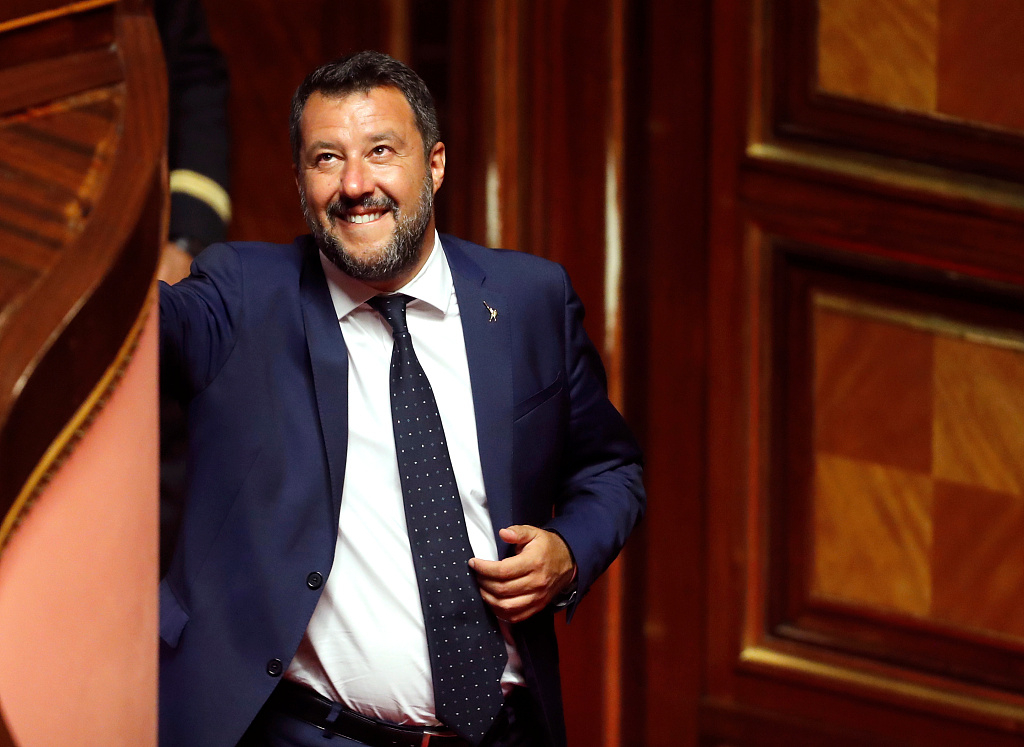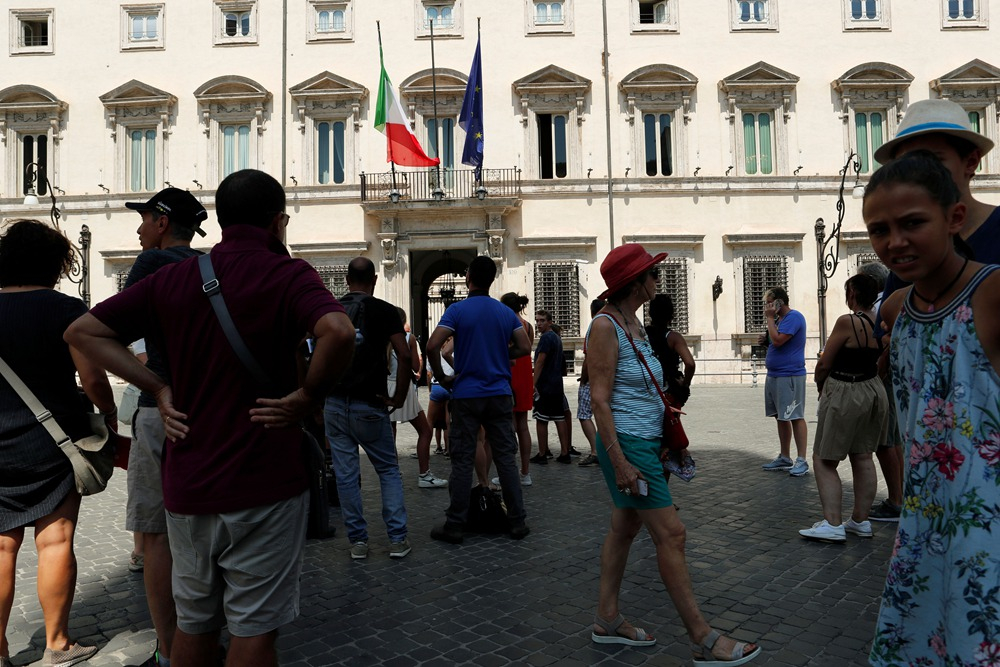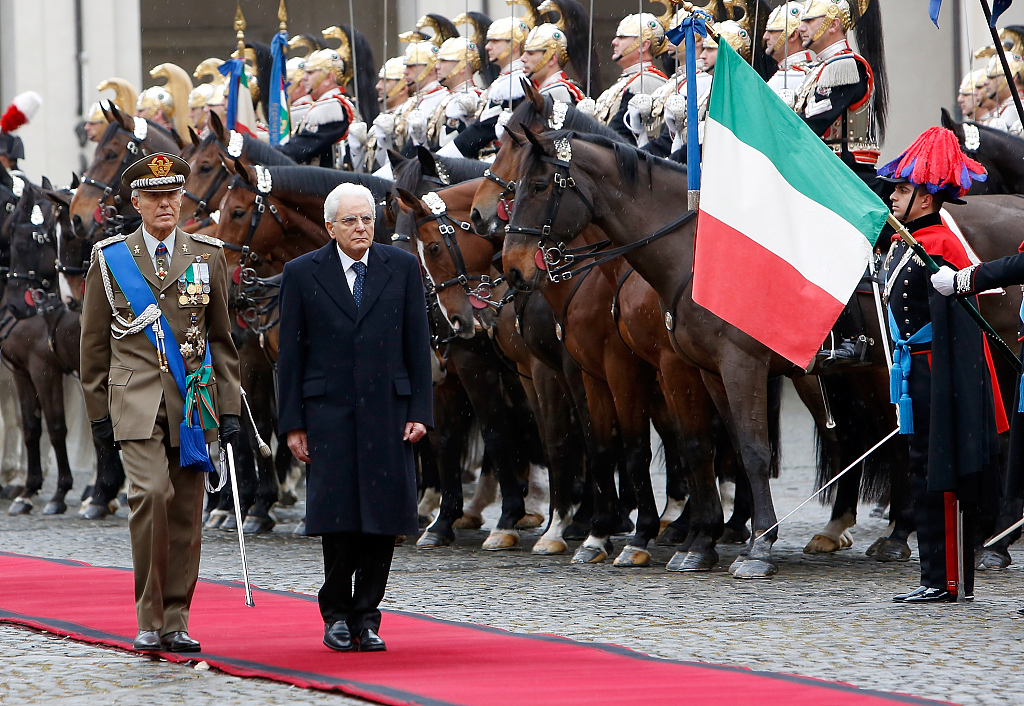

Italy's Prime Minister Giuseppe Conte (C), Deputy Prime Minister Matteo Salvini (R) and Deputy Prime Minister Luigi Di Maio leave at the end of a news conference after a cabinet meeting at Chigi Palace in Rome, Italy, October 20 2018. /Reuters Photo
Italy's ruling League party filed a no-confidence motion against the prime minister on Friday, a move that the party's populist chief, Matteo Salvini, hopes will trigger snap elections and install him as the nation's new leader.
The heads of political groups in the Senate will meet on Monday to set a date for holding the no-confidence vote, the upper house press office said in a statement on Friday.
Salvini said the ruling coalition is unworkable after months of open bickering.
"Too many no's are hurting Italy which instead needs to return to grow and therefore head to the polls quickly," the League said in a statement a day after Salvini pulled the plug on its coalition with the anti-establishment 5-Star Movement.
"Those who waste time are harming the country and only thinking about holding onto their posts," it added.

Italy's Deputy Prime Minister and Interior Minister Matteo Salvini smiles as the government is set to face Senate confidence vote on security and immigration decree in Rome, Italy, August 5, 2019. /VCG Photo
Salvini's shock announcement, which followed a period of intense public feuding between the two parties, throws the euro zone's third-largest economy into deeper political uncertainty just as it was due to start 2020 budget preparations.
An election could be held as early as October.
Salvini said in a statement on Thursday he had told Prime Minister Giuseppe Conte, who belongs to neither coalition party, that the alliance with 5-Star had collapsed after barely a year in power and "we should quickly give the choice back to the voters". He said cabinet meetings were dogged by disputes.
The head of state, President Sergio Mattarella, is the only one with the power to dissolve the parliament, but he could first try to form a new government from the existing legislature before resorting to elections.
Salvini urged lawmakers on Friday to return to parliament in Rome and break their summer vacations. "There's nothing to say that we cannot make parliamentarians work in the middle of August. Lawmakers should get off their bums and work."
The political crisis has jolted Italians out of their August torpor, with millions of voters holidaying on the beach and facing the first autumn election in Italy's post-war history.

Tourists and media members are seen outside the Chigi Palace following the news that League's leader and Deputy Prime Minister Matteo Salvini declared the governing coalition to be unworkable and called for new elections, in Rome, Italy, August 9, 2019. /Reuters Photo
What happens next?
Salvini has sparked a political crisis by calling for snap elections, but the deputy prime minister has little influence over what comes next. Here is what can be expected in Rome over the coming days and weeks:
- Back from the beach
Both houses of parliament – the Senate and Chamber of Deputies – have shut for the summer. Before any vote can be held that could bring down the government, the heads of both chambers will have to convene the leaders of parliamentary groups to lay down a timetable, and give MPs time to get back from the beach.
Under Senate rules, any no-confidence motion has to be addressed within 10 days, so no later than August 20.
The chamber that first voted in the prime minister at the beginning of his term gets first vote on a no-confidence motion. In Conte's case, he got the nod from the Senate first – some 14 months ago. If the motion passes there, it will be enough to bring down the government, without it having to be put to the lower house as well.

Newly elected Italian President Sergio Mattarella arrives at Quirinale in Rome, Italy, February 3, 2015. /VCG Photo
- Resignation
Conte would then have to submit his resignation to President Mattarella, who would ask him to remain on for a few days while consultations with the parties are held.
Mattarella would meet for talks with the presidents of both chambers of parliament as well as the party leaders – in addition to consulting with his predecessor, Giorgio Napolitano. This stage usually takes two to three days.
If, as expected, it is not possible to cobble together a parliamentary majority through alliances with other parties, he will dissolve parliament. This could happen around August 26, according to political observers.
- Ballot boxes
From that moment on, Italy must vote within 70 days. General elections are usually held after the 60 days necessary to organize postal votes for Italians abroad.
The question remains as to who will lead Italy to the polls. Mattarella will try to find a solution which suits all parties: Conte could stay on until the vote, or the parties may decide to name an interim prime minister. Or they may fail to agree, at which point Mattarella could appoint someone himself.

Copyright © 2018 CGTN. Beijing ICP prepared NO.16065310-3
Copyright © 2018 CGTN. Beijing ICP prepared NO.16065310-3